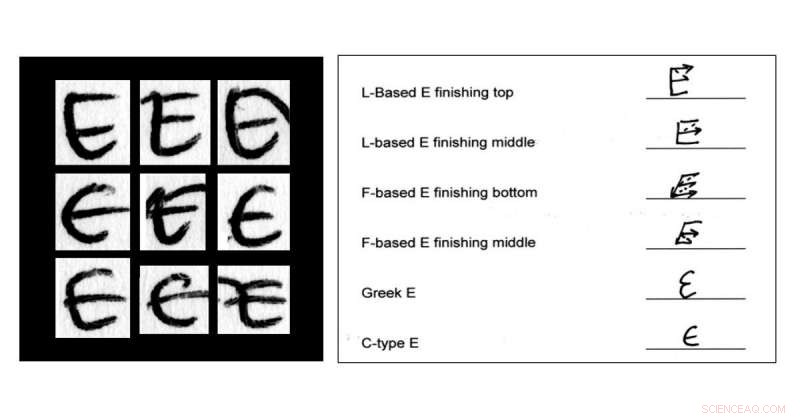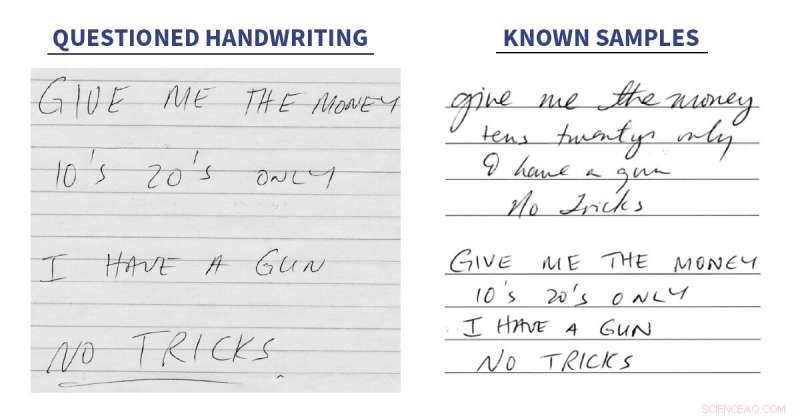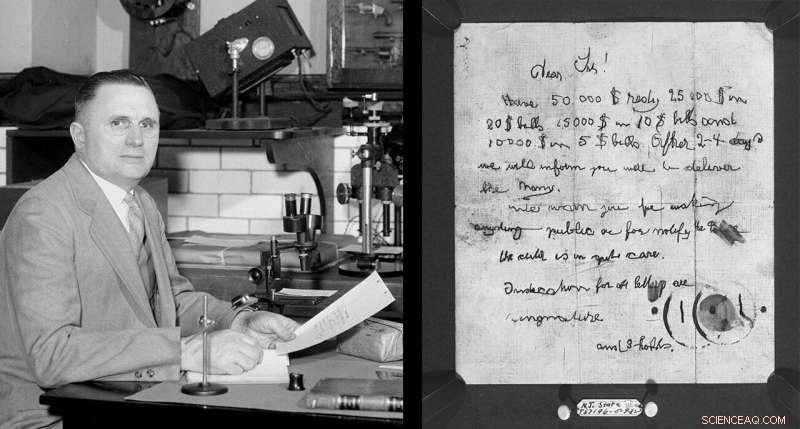
Une gamme de variation naturelle dans la lettre majuscule "E" d'un écrivain. Crédit :NIST
Les gens écrivent plus que jamais avec leurs claviers et téléphones, mais les notes manuscrites sont devenues rares. Même les signatures se démodent. La plupart des achats par carte de crédit n'en nécessitent plus, et s'ils le font, vous pouvez généralement en gratter un avec votre ongle. L'art séculaire de l'écriture manuscrite est en déclin.
Cela marque un changement profond dans la façon dont nous communiquons, mais pour un groupe d'experts, cela soulève aussi une question existentielle. Les examinateurs d'écriture manuscrite authentifient les notes et les signatures manuscrites - ou révèlent qu'il s'agit de faux - en analysant les caractéristiques distinctives de notre écriture. Comme les gens écrivent moins à la main, l'examen d'écriture deviendra-t-il inutile?
Un rapport récent de l'Institut national des normes et de la technologie (NIST) suggère que la réponse est non, si le domaine change pour suivre le rythme. Mais les temps changent à plus d'un titre, et le déclin de l'écriture manuscrite n'est qu'un des défis avec lesquels le domaine devra compter.
Comment les experts le font
Emily Will est une examinatrice d'écriture certifiée en pratique privée en Caroline du Nord. Elle a examiné les signatures sur d'innombrables chèques, volontés, actes et fiducies. Elle a inspecté les dossiers médicaux pour évaluer si la signature d'un médecin a pu être ajoutée à une date ultérieure à celle indiquée, peut-être après le dépôt d'une plainte. Elle a également examiné des formes plus longues d'écriture, comme des lettres de menace ou de harcèlement et des notes de suicide. Si la victime apparente du suicide n'a pas écrit la note, la police pourrait avoir un homicide sur les mains.
Pour évaluer si un morceau d'écriture a été écrit par une personne en particulier, les examinateurs ont besoin de quelque chose pour le comparer, ils collectent donc des échantillons d'écriture dont on sait qu'ils proviennent de cette personne. Le type d'écriture doit être le même, qu'il s'agisse d'une signature, écriture cursive, ou l'impression à la main. Les échantillons connus doivent être à peu près de la même période que l'écriture en question, car notre écriture évolue avec le temps. Et avoir plusieurs échantillons connus à comparer est la clé, car cela permettra à l'examinateur de prendre en compte la variabilité du style d'écriture d'une personne.
"Tu n'es pas un robot, donc chaque fois que vous signez votre nom, ça sera différent, " dit Will. "C'est ce qui rend l'examen d'écriture si intéressant."
Les non-professionnels pourraient penser que puisque la plupart des gens savent comment produire une écriture manuscrite, à peu près tout le monde peut l'examiner. Ils pourraient supposer que l'expert compare des choses telles que la taille, l'inclinaison et l'espacement des lettres et les connexions entre elles. En effet, les examinateurs le font. Mais ils regardent aussi au-delà de ces caractéristiques de l'écriture pour des signes plus subtils de la façon dont l'écriture a été faite.
"Dites que vous voulez falsifier une signature, » dit Will. « Vous pourrez peut-être faire un bon fac-similé. Mais le "O" est-il dans le sens des aiguilles d'une montre alors qu'il devrait être dans le sens inverse des aiguilles d'une montre ? Y a-t-il des ascenseurs de stylo là où il ne devrait pas y en avoir ? Lorsque vous signez votre nom, c'est de la mémoire musculaire. ." Ces hésitations apparaissent au microscope comme de minuscules flaques d'encre.
"Ce n'est pas tant à quoi ressemble la signature, mais comment il a été exécuté c'est important, " dit Will.
Voici ce que Will transporte dans son sac de voyage :une loupe de bijoutier, un petit microscope optique et un microscope numérique à main. Une lampe de poche. Un micromètre en papier, pour mesurer l'épaisseur du papier. Un ordinateur portable et un scanner portable. Une caméra qui se branche sur ses microscopes. « Et franchement, " elle dit, "J'utilise beaucoup mon iPhone ces jours-ci."
La pratique de Will s'étend au domaine plus large de « l'examen de documents contestés, " qui consiste à scruter un document entier à la recherche de signes de fraude. Dans son laboratoire, elle dispose d'équipements pour analyser les papiers et les encres et les visualiser sous différents types de lumière. Certaines encres qui semblent identiques à la lumière du jour sont très différentes sous infrarouge. Elle identifie les ratures, altérations et oblitérations et révèle une écriture en retrait - les impressions laissées sur des feuilles de papier sous la note écrite.
Mais la plupart du travail de Will implique l'écriture manuscrite et les signatures, et il y en a beaucoup moins de nos jours. La fraude à l'encaissement de chèques est en baisse maintenant que les chèques de paie et les chèques de sécurité sociale sont déposés directement. Les poursuites pour faute professionnelle médicale impliquent moins de signatures depuis que les dossiers de santé électroniques sont devenus la norme. Even celebrities have noticed the change. In a 2014 opinion article in The Wall Street Journal, Taylor Swift wrote, "I haven't been asked for an autograph since the invention of the iPhone with a front-facing camera."
Enough handwriting still passes under Will's microscope to keep her in business. Mais, elle dit, "If I were a young person starting out today, I might consider cybersecurity."

Forensic handwriting examiners can only compare writing of the same type. Dans ce cas, only the second known sample can be compared to the questioned handwriting. Crédit :NIST
A Roadmap for Staying Relevant
The field of forensic handwriting examination may have trouble attracting new blood. A report from NIST earlier this year found that the median age for handwriting examiners is 60, compared with 42 to 44 for people in similar scientific and technical occupations. That report, Forensic Handwriting Examination and Human Factors:Improving the Practice Through a Systems Approach, was published by NIST, but was written by 23 outside experts, including Will.
To increase recruitment, the report recommends replacing the unpaid apprenticeships that have been the traditional route of entry into the field with grants and fellowships. The report also recommends cross-training with other forensic disciplines that involve pattern matching, such as fingerprint examination.
The "human factors" in the report's title refers to a field of study that seeks to understand the factors that affect human capability and job performance. In forensic science, these include training, communication, technology and management policies, to name just a few.
Melissa Taylor, the NIST human factors expert who led the group of authors, said that the report provides the forensic handwriting community with a road map for staying relevant. But the threat of irrelevance doesn't come only from the decline in handwriting. Part of the challenge, elle dit, arises from the field of forensic science itself.
"There is a big push toward greater reliability and more rigorous research in forensic science, " dit Taylor, whose research is aimed at reducing errors and improving job performance in handwriting examination and other forensic disciplines, including fingerprints and DNA. "To stay relevant, the field of handwriting examination will have to change with the times."
Among other changes, the report recommends more research to estimate error rates for the field. This will allow juries and others to consider the potential for error when weighing an examiner's testimony. The report also recommends that experts avoid testifying in absolute terms or saying that an individual has written something to the exclusion of all other writers. Au lieu, experts should report their findings in terms of relative probabilities and degrees of certainty.
These recommendations are consistent with findings in a landmark 2009 report from the National Academy of Sciences. Called Strengthening Forensic Science in the United States:A Path Forward, that report said that "there may be a scientific basis for handwriting comparison, " but that there has been only limited research on its reliability.
Knowing When to Not Make a Call
Children used to learn handwriting in school by copying letters and phrases from books that contained models of ideal penmanship. Different copybooks had different styles, and an expert could often tell from a person's handwriting whether they were trained in the Palmer style, the Spencer style, or something else. By identifying a specific copybook style, an examiner could quickly narrow the range of potential writers.
Many children no longer learn cursive writing in school, and whether this helps or hinders handwriting examination is unknown. "It might actually make handwriting more identifiable because it allows people to develop their own individual styles of writing, " said Linton Mohammed, author of the widely used textbook Forensic Examination of Signatures, and a co-author of the NIST-led study.
D'autre part, it might make the task harder by depriving experts of a system for classifying writing styles. This is one reason why research on error rates is needed. The way people learn to write has changed, and error-rate studies can show whether handwriting examiners are successfully adapting to those changes. "We claim to be good at this, " Mohammed said. "But how good are we really?"
Several studies have attempted to answer this question by testing whether experts are more competent at handwriting examination than people with no training. The results reveal a great deal about both handwriting examination and human psychology.

In the 1930s, a physicist at NIST, then known as the National Bureau of Standards, became a leading handwriting expert. His name was Wilmer Souder, and the most famous case he worked on was 1932 the kidnapping of Charles Lindberg Jr., the infant son of the famous aviator. Despite the notoriety of this case, Souder himself kept an extremely low profile — so much so that when he retired, a profile in "Reader's Digest" referred to him as Detective X. Credit:NBS/NIST; source:NARA
In many of these studies, participants are shown pairs of signatures and asked to determine whether they are both by the same person or if one is a fake. Calculating overall error rates from multiple studies is difficult due to differences in study design. But consistently, across studies, both experts and novices made roughly the same proportion of correct decisions, according to a 2018 metastudy led by Alice Towler at the University of New South Wales, Australia. The novices, cependant, made a much higher proportion of errors, while the experts more frequently declined to make a call. If a signature lacked complexity or was otherwise difficult to compare, the experts would more readily find the evidence inconclusive. This ability to defer judgment is critical to reducing errors in forensic science.
The tendency of novices to rush to judgment in cases where experts defer reflects a quirk of human psychology. People with limited knowledge or expertise in a subject often overestimate their own competence. This is called the Dunning-Kruger effect, for the psychologists who first described it. In the case of handwriting, people might be particularly susceptible. Après tout, pretty much anyone can produce handwriting. How hard can it be to examine?
But error rate studies show that at least some experts recognize their limitations when faced with a difficult task. "I've been doing this for 30-plus years, and I realized early on that there's a lot that we don't know, " Mohammed said. "So we have to be very careful in reaching our conclusions."
The End of Handwriting Examination, or a New Beginning?
Like Emily Will, Mohammed has examined many wills, deeds and trusts. He has also analyzed ransom notes, threatening letters, and one hit list. Being based in the San Francisco Bay Area, where the tech boom has minted many fortunes, he has also examined many stock-option grants and prenuptial agreements.
Although Mohammed started his career with the San Diego County Sheriff's Department, today he is in private practice. In his current home base of northern California, il dit, there are no government laboratories that still examine questioned documents. This reflects a nationwide trend—a report from the Department of Justice found that only 14% of publicly funded crime labs did their own questioned document examinations in 2014, down from 24% in 2002.
Those numbers may mean that the field is consolidating rather than disappearing. If smaller labs can no longer support in-house experts due to a diminishing caseload, they can farm out work to private sector experts like Will and Mohammed. À la fois, larger federal labs, including the FBI Laboratory and the U.S. Army's Defense Forensic Science Center, continue to maintain questioned document units. This is in part because their focus includes international terrorism, where handwritten documents are still a source of valuable intelligence, and in part because the United States is a big place. Nationwide, crimes involving handwriting still occur frequently enough that federal labs need to keep experts on staff.
When asked if handwriting examiners will soon become irrelevant, one federal expert said that as long as greed and fraud exist, there will be a need for handwriting examiners.
When asked the same question, Mohammed noted that changing technology did not doom the field in the past. "When the ballpoint pen came out, people said, "That's the end of handwriting examination, '" he said. People mostly stopped using fountain pens, but handwriting examination survived the transition.
Melissa Taylor, the NIST expert, agrees that handwriting examination is still a needed skill and will remain relevant—if the field successfully adapts to changing expectations around research and reliability. And if the new report, which counts many leading handwriting experts among its authors, is any indication, the needed changes may already be underway.
"There will still be documents. There will still be signatures, " Taylor said. "And most people don't print stickup notes on their laser printer. They scribble them on the dashboard before running into the bank."
Some things will never change.